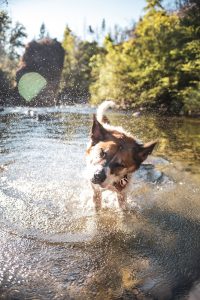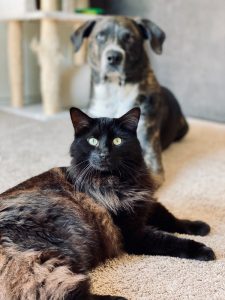The post Why is a Routine Vet Visit So Important appeared first on Willow Grace Veterinary Hospital.
]]> You wouldn’t disregard your own health checkups, so why should your pet? Routine veterinarian visits are one way to monitor your pet’s health.
You wouldn’t disregard your own health checkups, so why should your pet? Routine veterinarian visits are one way to monitor your pet’s health.
A routine veterinarian visit can help maintain your pet’s overall health as well as monitor their diet, exercise, and supplementation.
Your pet is a member of your family.
We believe that your pet is a family member. When something is wrong, you can trust our team to diagnose the problem and make treatment recommendations – not just a prescription for antibiotics or expensive surgery.
Our team will become acquainted with your pet and be able to provide customized advice as well as treatment recommendations based on recent medical history and ongoing health concerns.
Vaccinations
Dogs and cats should receive all necessary vaccinations as soon as possible following their initial vaccination. Our clinic strives to provide affordable immunizations and other preventive services.
Heartworm
If your pet is at risk due to the environment in which he or she spends the majority of his or her time (for example, a backyard dog who spends part of the day outside), heartworm testing is also recommended.
Diet and Exercise
During your pet’s routine visit, our team can ensure your pet is within a healthy range. We can also discuss your pet’s diet and lifestyle. Routine exercise and weight management can help prevent certain health conditions, like heart disease and cancer.
Prevention is key to your pet’s wellbeing.
The most important component of everyday pet care is prevention. Even if your pet is healthy, you should keep an eye out for health issues and address them promptly.
However, if your pet is unwell, starting treatment immediately will prevent their condition from worsening. Our veterinarians can create a treatment plan that is best for your pet’s symptoms.
A routine veterinarian visit is an important part of keeping your pet healthy and happy. Proper health maintenance enables you to spend more time caring for your pet, and there are numerous options for determining how frequently you should bring them in for an examination.
We can assist you in maintaining your pet’s optimal health! For more information please contact Willow Grace Veterinary Hospital today.
The post Why is a Routine Vet Visit So Important appeared first on Willow Grace Veterinary Hospital.
]]>The post Reasons to Consider Spaying or Neutering Your Pet appeared first on Willow Grace Veterinary Hospital.
]]> Within the United States, it is estimated that nearly 80% of family pets are spayed or neutered. If you recently added a pet to your family, you may have been asked if you plan to spay or neuter. There can be many questions regarding the process and why you should consider it for your pet’s wellbeing. This month, we would like to share some of the reasons you should consider spaying or neutering your pet.
Within the United States, it is estimated that nearly 80% of family pets are spayed or neutered. If you recently added a pet to your family, you may have been asked if you plan to spay or neuter. There can be many questions regarding the process and why you should consider it for your pet’s wellbeing. This month, we would like to share some of the reasons you should consider spaying or neutering your pet.
Spaying and Neutering
Spaying is a surgical procedure that involves removing a female animal’s reproductive organs to prevent reproduction. This procedure involves removing her ovaries and occasionally the uterus as well. In many cases, the female may no longer experience a heat cycle.
Neutering refers to the surgical procedure performed to prevent a male dog from being able to reproduce. This procedure, also known as castration, involves removing the testicles and other associated reproductive organs.
When Can I Spay or Neuter My Pet?
You can have your pet spayed or neutered at almost any point in their life. However, the American Animal Hospital Association, or AAHA, recommends that most dogs and cats be spayed or neutered around 5 to 6 months of age. For larger or giant breeds, pet owners should wait until their pet is finished growing around 9 to 15 months of age.
For rabbits, females can be spayed around the age of sexual maturity around 6 months of age while males can be neutered once the testicles descend.
It is important to note that each pet is unique, your vet will conduct a thorough physical examination and discuss when treatment is ideal for your pet.
Benefits of Treatment
You can increase your pet’s chance of living a long and healthy life. Spaying or neutering your pet can reduce their risk of developing serious health conditions such as mammary cancer, pyometra, testicular cancer, and prostate problems.
In some cases, treatment may also reduce the frequency of unwanted behaviors such as urine-marking, roaming for females in heat, mounting, and lower levels of aggression. However, treatment is not a cure for behavioral problems and is not proven to eliminate these behaviors or change their behavior.
If you wish to prevent unwanted litters or help decrease the number of homeless animals in need, then spaying or neutering can be an ideal treatment option.
Your Decision
We are dedicated to helping you ensure your pet lives a happy and healthy life as such as we cannot make a blanket recommendation. Instead, we are here to help you navigate your pet’s health plan and make an educated decision about how best to care for them. Just like you, your pet has his or her quirks, personality, and needs so their care must be customized to suit their health and your family’s lifestyle. For more information on spaying and neutering or to schedule an appointment, contact Willow Grace Veterinary Hospital today.
The post Reasons to Consider Spaying or Neutering Your Pet appeared first on Willow Grace Veterinary Hospital.
]]>The post Tips To Help Your Pet Stay Calm During Halloween appeared first on Willow Grace Veterinary Hospital.
]]> Many of us get excited for fall holidays and activities such as harvest parties and Halloween, but for our non-human companions, this can be a stressful time. If you are a pet parent, it is important to understand that your dog’s instinct is to protect its home and alert you to strangers while your cat often prefers their normal quiet routine. The hustle and bustle of fall can easily stress out your pet and create unnecessary anxiety. This October, as you decorate for fall and prepare for festivities, here are some recommendations to help you be mindful of your pets.
Many of us get excited for fall holidays and activities such as harvest parties and Halloween, but for our non-human companions, this can be a stressful time. If you are a pet parent, it is important to understand that your dog’s instinct is to protect its home and alert you to strangers while your cat often prefers their normal quiet routine. The hustle and bustle of fall can easily stress out your pet and create unnecessary anxiety. This October, as you decorate for fall and prepare for festivities, here are some recommendations to help you be mindful of your pets.
Lower Your Pet’s Stress
If you plan on hosting any holiday parties or handing out candy this month, be sure to provide your pet with a quiet room where they can feel safe and relax. If your pet is likely to get anxious throughout the night or attempt to escape, we recommend keeping them comfortable in a closed room or in their crate with soft music in the background and a favorite toy to keep them calm. This can be a great way to keep them distracted from the sounds of holiday activities. Place a sign on the door so guests know it is off-limits.
Even if you are only inviting friends over and your pet is sociable, it is a good idea to provide them with a calm safe space. Masks and costumes can change how people look and smell to your pet, making them wary of even familiar faces.
Stow Away Candy
Store candy and holiday foods out of reach from curious pets in a child-proof container as many candies and treats such as chocolate, gum, and xylitol (a common sweetener used in foods) can be toxic to pets. If you have children, keep an eye out to make sure they aren’t sharing their loot with their best furry friend.
During the holiday season, it is important to keep the ASPCA Animal Poison Control Center hotline number handy, 888-426-4435. If you suspect your pet has eaten something toxic, call your vet or poison control immediately.
Decorate Mindfully
With the holiday season approaching, it’s time to start thinking about decorations. Though decorating around the house can be exciting and fun, sudden changes to your home can make your pet anxious. Fake spiders or motion-activated devices may be seen as a threat and cause your pet to attack or become aggressive.
Some decorations may have obvious signs of danger such as real candles, while others may be more subtle like small spiders and fake webbing that can easily become choking hazards. Glow sticks, fake blood, potpourri, lights, and real flowers can be dangerous and toxic to pets. Make sure to decorate your home in a way that is safe for your animal companions.
Costume Considerations
Though your pet may look cute in a costume, we recommend against pet costumes unless you are sure your pet likes wearing them. A mask and hat can be great for a quick photo opportunity but oftentimes, your pet may get uncomfortable and try to take off their costume. Signs that your pet may not like their costume can include ears folded down, tucked tail, trying to bite parts of the costume, and rolling around in an attempt to take it off.
If your pet doesn’t mind their costume, make sure it is comfortable and allows them to move freely. Remove any dangling, small, or chewable costume accessories or pieces to avoid choking hazards.
We also recommend introducing yourself to your pet in your costume as they may not recognize you and be frightened by your new appearance. It may be helpful to let your pet watch you put on your costume.
Protect Your Pet
In the days approaching Halloween, it may be a good idea to bring your pets indoors before nightfall, so they don’t become agitated or attempt to escape from holiday festivities. Make sure they have a lot of physical activity throughout the day so they can feel tired and more relaxed during nightfall.
It is important that you make sure your pet always wears their ID tag and that all the information on their microchip is up to date in the event of an escape. This information will help to recover your lost pet.
Fall activities don’t have to be stressful for your pets, we hope that these few tips will help to keep your pet calm and relaxed during the month. For more information on how to help your pet stay safe during Halloween or to schedule an appointment, contact Willow Grace Veterinary Hospital today.
The post Tips To Help Your Pet Stay Calm During Halloween appeared first on Willow Grace Veterinary Hospital.
]]>The post Animal Pain Awareness appeared first on Willow Grace Veterinary Hospital.
]]> As animal lovers, the last thing we want to think about is our pet being hurt or uncomfortable and going unnoticed. It can be difficult to determine when your pet is in pain, but we are here to help! This month we are participating in Animal Pain Awareness!
As animal lovers, the last thing we want to think about is our pet being hurt or uncomfortable and going unnoticed. It can be difficult to determine when your pet is in pain, but we are here to help! This month we are participating in Animal Pain Awareness!
Animal Pain Awareness Month
September is Animal Pain Awareness Month, and during this month we join thousands of veterinarians around the world to raise awareness about animal pain, signs to look for, and how to best manage your pet’s pain.
Unfortunately, animals can’t tell us when they are hurting, how badly they are hurting, or if they don’t feel well. Many animals have adapted through evolution to be masters of disguising pain to avoid the attention of predators. As pet parents, it is important when spending time with our pets to make note of any changes in their routines, behavior, or health that may indicate something awry. Early detection allows for early intervention and treatment which can help our beloved pets on the road to recovery.
Signs and Symptoms
Acute pain and trauma injuries can be easy to recognize in animals as vocalizations, limping, and visual open wounds will catch our attention. However, there are other ways of knowing if your pet is not feeling well. Here are some common signs that your pet may be in pain:
- Anxiety
- Changes in bathroom habits
- Decreased appetite and hydration
- Decreased grooming as the area may be too painful to touch
- Difficulty standing after resting
- Excessive and focused licking, grooming, or chewing areas of the body
- Excessive sleeping
- Growling or increased aggression in dogs
- Heavy panting
- Hiding or refusing to come when called
- Hissing or spitting in cats
- Hunching in cats
- Lack of agility
- Lethargy
- Loss of interest in playing and curiosity
- Reduced activity
- Reluctance to run or jump
- Shifts in routine, especially in favorite areas of rest
- Trembling or shaking
- Weight loss
- Whimpering
Many times, pain can be dismissed as signs of age or becoming older; age is not an illness and should not be painful. If your pet is showing these signs, please contact our veterinarian. It is also important to note that these signs will have to be compared to your pet’s normal behavior and personality. For example, excessive sleeping can be harder to spot in cats than in some dogs.
Managing Your Pet’s Pain
If you notice your pet displaying one or more of these signs, we strongly recommend contacting your vet to schedule an appointment. Even if you consider the change to be minor, your vet will be able to determine through a comprehensive examination if any ailment or condition is affecting your pet’s health.
There are many treatment options available to help treat and relieve pain in animals including medication, physical therapy, supplements, acupuncture, laser therapy, and massage. During your pet’s diagnosis, we will discuss possible treatment options for your pet’s care and help you determine which is the right one for their overall health and wellbeing.
For more information on how to recognize signs of pain in your pet or to schedule an appointment, contact Willow Grace Veterinary Hospital today.
The post Animal Pain Awareness appeared first on Willow Grace Veterinary Hospital.
]]>The post Canine Influenza appeared first on Willow Grace Veterinary Hospital.
]]> Though you may be familiar with flu outbreaks, did you know that your dog can catch the flu as well? Recent outbreaks of canine influenza across the country have many veterinarians asking patients to be mindful of their pet’s behavior and to bring them in if they show signs of illness to prevent the further spread of the virus. If you are a dog owner, no need to panic, but you should familiarize yourself with facts about the canine flu so that you can make sure your pet stays happy and healthy.
Though you may be familiar with flu outbreaks, did you know that your dog can catch the flu as well? Recent outbreaks of canine influenza across the country have many veterinarians asking patients to be mindful of their pet’s behavior and to bring them in if they show signs of illness to prevent the further spread of the virus. If you are a dog owner, no need to panic, but you should familiarize yourself with facts about the canine flu so that you can make sure your pet stays happy and healthy.
What is the Canine Influenza?
Canine influenza, also known as the dog flu, is an infectious respiratory disease caused by an influenza A virus. Two strains of the virus can cause canine influenza: H3N8 and H3N2. Both variants infect the respiratory system and are extremely contagious for dogs.
There are no reported cases of any humans having been infected with any variant of the canine influenza virus. Though it poses little to no threat to humans, dogs are 98% likely to catch the virus if they encounter an infected dog.
Signs and Symptoms
Common signs of canine influenza can include the following:
- Difficulty breathing
- Fever
- Lethargy
- Nasal discharge
- Reduced appetite
- Runny eyes
- Sneezing
- Wet or dry cough
It is important to note that your dog may not display all these symptoms. Though most cases are mild, some can turn severe. In severe cases, pneumonia may develop, and your pet will need more immediate veterinary care.
If you suspect your dog has canine influenza, contact your veterinarian, and schedule an appointment immediately.
How Does Canine Influenza Spread?
Similar to human forms of the flu, canine influenza is an airborne virus that affects the respiratory system of the host. It can spread through respiratory droplets from coughing, barking, and sneezing. It can also spread through contaminated objects in the environment such as water and food bowls, collars, kennel surfaces, bedding, and toys.
Crowded areas such as grooming facilities, kennels, doggy daycares or hotels, and dog parks can be breeding grounds for canine influenza. If an outbreak is reported in your area, be sure to avoid areas frequented by other dog owners.
Treatment
When going to the veterinarian be sure to mention your concerns as canine influenza is highly contagious. Your veterinarian may request that you wait outside until your appointment time to prevent spreading the virus within the waiting room.
Diagnosing canine influenza can be difficult without a veterinarian as the virus shares some symptoms associated with kennel cough. Your vet can conduct a physical examination and order any additional tests needed to confirm a diagnosis.
Treatment focuses on supporting your dog and keeping them comfortable during recovery.
In mild cases, cough suppressants may be given as well as non-steroidal anti-inflammatory medication to reduce any fever. If any secondary infection has developed as a result of the flu, antibiotics will also be administered.
Rest and isolation from other dogs are also key components to canine influenza treatment. Most vets recommend quarantine for a minimum of 21 days to reduce the risk of transmission and ensure a proper recovery.
In severe cases, your pet may be treated with fluids, broad-spectrum antibiotics, and supportive in-hospital care. Some cases can lead to pneumonia which can become serious and deadly when untreated.
Your vet will also discuss appropriate quarantine procedures to prevent the spread of the virus within your home and can give you information on pet-safe disinfectant solutions to help kill the virus in your home. All surfaces, clothing, leashes, collars, equipment, bedding, toys, and serving bowls need to be disinfected.
Prevention
There is a vaccine available for each strain. If you live in an area where outbreaks may be common or plan to travel with your pet a lot, your veterinarian may recommend the vaccine for your dog as a precaution.
The best way to prevent your dog from contracting canine flu is to keep him away from public areas such as dog-friendly parks and restaurants as well as kennels when recent cases are reported in the area. This will reduce your pet’s risk.
By knowing what to look for and what steps to take if you suspect your dog is ill, you can better care for your beloved furry friend. For more information on the canine flu or to schedule an appointment, contact Willow Grace Veterinary Hospital today.
The post Canine Influenza appeared first on Willow Grace Veterinary Hospital.
]]>The post Swimming With Your Pet appeared first on Willow Grace Veterinary Hospital.
]]> Swimming is an excellent way to beat the summer heat and bond with your pet. Dogs, guinea pigs, and even some cats may enjoy taking a dip with you. However, before you head to the waters, we want to make sure you are well informed about water safety when it comes to swimming with your pet this summer.
Swimming is an excellent way to beat the summer heat and bond with your pet. Dogs, guinea pigs, and even some cats may enjoy taking a dip with you. However, before you head to the waters, we want to make sure you are well informed about water safety when it comes to swimming with your pet this summer.
Getting Used to Water
Training your furry friend from a young age will help them to learn to enjoy the water. The bathtub or sink is the perfect starting point. Fill it with only a few inches and sit with your pet in the water. Allow them to get used to the water before splashing them so they don’t get overwhelmed. Yes–even with cats, begin with gradual experiences followed by plenty of treats for encouragement.
Take it slow, allowing your pet to show you signs of confidence. If your pet is comfortable with a few inches, continue to add more until your pet is comfortable with paddling or floating in the tub.
It is important to remember that though we assume all dogs can swim, for some it may be more of a survival “sink or swim” reaction than a fun activity. Your pet may need time to adapt to being in the water.
Safety First
Even once your pet is confident in the water, we recommend using a life vest or jacket to give your pet extra security. This can also help your pet stay afloat and keep them from tiring out as fast. Buy a vest that has a handle on the back in case you need to quickly remove your pet from the water.
Always keep your eyes on your pet around water, and never leave them unattended. Even if you are poolside, it can be easy for your pet to fall in and become disoriented or overwhelmed in the water. Consider using a safety cover for your pool when it is not in use. Keep them at your side at all times when at the beach, lake, stream, or other natural bodies of water.
Watch Out for Hazards
It is important to check the water before letting your pet rush in for a dip.
If you are at the beach, be mindful of strong waves and currents but also consider any objects under the water or on land that may injure your pet. Popular fishing areas could have hooks and wires, and broken shells or debris can also wound your pet while at the beach, so look carefully.
Lakes, ponds, and streams can be inviting too, but look out for blue-green algae, known as cyanobacteria. Not all blue-green algae blooms are poisonous so it is important to be cautious and check for signage when possible. If swallowed in even small amounts, your pet may suffer from impaired balance, difficulty breathing, drooling, tremors, liver failure, shock, and seizures as well as gastrointestinal problems. If you think your pet has been exposed, rinse their mouth and contact your vet right away.
If you want your pet to join you in the pool, be sure to maintain your chemicals as some can be toxic and harm your pet if not in the right balance.
Provide Fresh Water and Shade
Though you’ll be spending time in the water, it is still important to provide fresh potable water to your pet frequently. Drinking too much salt water or chlorinated water can create an upset stomach, dehydration, and vomiting.
The water may be cool but be sure to pick a spot in the shade for you and your pet to relax in to prevent them from overheating or sunburn.
Rinse and Dry
Once you are done swimming with your pet, be sure to rinse their coat thoroughly with fresh water to wash off any sand, salt, or chemicals that may be still on your pet’s coat. Use a soothing shampoo if you are able for sensitive skin and brush out their coat. Make sure their ears are dry to prevent infections. We also recommend checking their paws for any signs of injury.
With these tips in mind, you and your pet can enjoy spending time in the water together this summer. Always talk to your vet before taking on the task of swim lessons with your pet. Remember to only use bug repellents and sunscreens that are made for pets and approved by your veterinarian. For more information on swimming with your pet or to schedule a consultation, contact Willow Grace Veterinary Hospital today.
The post Swimming With Your Pet appeared first on Willow Grace Veterinary Hospital.
]]>The post Keeping Your Pet Cool During Summer appeared first on Willow Grace Veterinary Hospital.
]]> As the temperature rises and summer arrives, it is important to take steps in protecting your pet against the heat and humidity. Whether you are out for a walk, riding in the car, or letting him play in the yard, the heat can take a toll on your pet’s health. We can help you keep your pets safe and cool this summer with the following tips.
As the temperature rises and summer arrives, it is important to take steps in protecting your pet against the heat and humidity. Whether you are out for a walk, riding in the car, or letting him play in the yard, the heat can take a toll on your pet’s health. We can help you keep your pets safe and cool this summer with the following tips.
Exercising in the Heat
Plan your activities ahead of time if you plan on taking your pet outside with you. On very hot days, limit exercise to the early mornings or evenings when it will be cooler. The heat is not the only factor to watch out for, as levels of high humidity can also affect your pet’s ability to cool off.
Remember to always carry water with you to keep your pet from dehydrating. During activities give water every 15-20 minutes and if your pet begins to pant excessively, give him shade and water right away. Be mindful of your pet, especially those with light-colored coats as these pets can be more susceptible to sunburn.
Your pet’s paws can be sensitive and burn on hot pavements. Even on mild days, the pavement can be hot under the sun. If water steams on the pavement, it is too hot for your pet’s paws. You can also test the heat with your hand. If it is too hot for you, it is too hot for your pet!
Fresh Water and Shade
Don’t leave your pet outside alone during the summer for too long. If your pet is going to spend time outside, make sure he has shade and lots of fresh, cool water. In days of extreme heat and humidity, add ice cubes to the water.
Trees and open structures like tarps provide better protection from the sun than doghouses as they allow air to flow through, whereas closed structures such as a doghouse can trap heat inside making it worse for your pet.
Grooming
During the summer, you may be tempted to shave your pet’s coat to help keep him cool, but we recommend asking your vet first. The layers of your dog’s coat, even if a dark-colored coat, help to prevent overheating and sunburn. Keep your pet cool with regular grooming sessions that keep your pet’s coat clean and free of knots and matting as these can trap heat.
Hot Cars
Never leave your pet alone in a parked car, even if the windows are cracked. Cars parked in direct sunlight can reach temperatures up to 175°F internally when it is above 80°F outside. Even if it seems mild outside, a car can quickly rise in temperature making it unbearable for your pet. Never leave your pet alone, as “not long” is too long. Leave your pet at home or go places where he can come with you.
Inside the House
If you leave your pet at home alone, be sure he will be comfortable and cool. Leave the air conditioner on for him ⁰and close the drapes. If you don’t have air conditioning, open the windows, and turn on a fan. Cooling mats or cooling fabric pet attire can help your pet stay cool while you are away.
Heat Stroke
If your pet is outside for lengthy periods in high heat and humidity, he can be at risk for a fatal heatstroke. Unlike us, our furry friends don’t sweat through their skin and rely on panting to keep them cool.
If your pet’s internal temperature rises above 104, he may begin to show signs of heatstroke and if his temperature continues to rise it may lead to organ failure and possible death. Warning signs of heatstroke include heavy panting, glazed eyes, drooling, rapid heartbeat, difficulty breathing, excessive thirst, lethargy, fever, vomiting, disorientation, and seizures.
If you notice any of these symptoms, get your pet to a cooler environment as soon as possible and call your veterinarian for further instructions. Once under shade or indoors, cool your pet down with cold water, not freezing, and rinse his mouth to help lower his temperature. Be particularly careful with short-nosed dogs such as bull breeds, boxers, pugs, older dogs, and those that are overweight. These dogs can get heatstroke simply by running around.
The summer is a great time to spend outside with your pet but be sure you take these precautions to help keep him safe and cool. For more information on how to keep your pet cool this summer or to schedule an appointment, contact Willow Grace Veterinary Hospital today.
The post Keeping Your Pet Cool During Summer appeared first on Willow Grace Veterinary Hospital.
]]>The post Allergies appeared first on Willow Grace Veterinary Hospital.
]]> Have you noticed your pet itching, scratching, chewing, or licking excessively? Does he sneeze frequently and shake his head or rub his face often? These may be signs that your pet has allergies. Just like us, your pet can be allergic to a variety of substances he breathes in, eats, or encounters within the environment.
Have you noticed your pet itching, scratching, chewing, or licking excessively? Does he sneeze frequently and shake his head or rub his face often? These may be signs that your pet has allergies. Just like us, your pet can be allergic to a variety of substances he breathes in, eats, or encounters within the environment.
Types of Allergies
There are different types of allergies that your dog or cat can experience: flea, food, and environmental allergies.
Flea
Flea allergies are the most common allergy experienced in pets. This condition is a hypersensitivity to the proteins or antigens found in flea saliva. When a flea bites a cat or dog, a small amount of saliva is released and triggers a reaction from your pet’s immune system causing extreme itchiness and skin irritation throughout the body not only at the bite.
Food
Food allergies are the result of an immune response and are different from a food sensitivity or intolerance, though some symptoms can be similar. Food allergies can result in a range of symptoms from facial swelling, itchiness, and gastrointestinal symptoms such as vomiting and diarrhea. In severe cases, anaphylaxis may occur. Food sensitivities and intolerances are generally less severe and often limited to digestive problems.
Beef, dairy, wheat, egg, chicken, lamb, and soy are the most common food allergens for dogs while beef, dairy, and fish are more common in cats.
Environmental
Environmental allergies are from allergens present in your pet’s environment and include dust, fungi, pollen, mold, plants, grass, mildew, perfumes, cleaning products, and smoke. Though seasonal allergies are environmental, some of the allergens may be present all year-round and result in constant irritation. Environmental allergies do not have to be from close contact as your pet can also inhale allergens.
Allergic contact dermatitis is another form of allergic reaction that is often caused by chemicals or products that encounter your pet’s skin. This can include detergents, soaps, natural and synthetic fibers, paint, cleaning products, and insecticides. Excessive itching, redness, and irritation are the most common symptoms on and around the site of contact. Secondary symptoms may appear such as hair loss, sores, scabbing, and hot spots.
Signs and Symptoms
Symptoms of allergies can vary depending on the cause and type of allergy. The following signs may be a sign of an allergic reaction.
- Constant licking or grooming
- Diarrhea
- Ear infections
- Excessive itchiness
- Facial swelling
- Hives
- Itchy ears
- Red, inflamed skin
- Runny eyes
- Sneezing
- Vomiting
- Difficulty breathing
It is important to note that these symptoms can also be signs of another condition.
Your pet may not present all of the symptoms listed above in his allergic reaction. A pet that develops anaphylactic shock from a food allergy will display different symptoms from a pet with a flea allergy.
Diagnosing Your Pet’s Allergies
Diagnosing allergies can be difficult as the symptoms of allergies could be caused by another medical condition. It is important if you suspect your pet has allergies to contact your vet so that they can diagnose your pet accurately and begin treatment immediately.
Your vet will review your pet’s medical history and complete a thorough examination. Allergy testing may be conducted with a blood or skin test. For a blood test, a sample of your pet’s blood will be sent to a laboratory for evaluation. For a skin test, small injections can be given to your pet just under the skin to see if a reaction develops. Both tests may be conducted to gain a better understanding of your pet’s allergies.
It is important to note that sometimes allergy testing may not always be a reliable method of diagnosing. Blood and skin tests can be ideal for determining some environmental allergies but are unreliable for food allergies. Food allergies may require eliminated diet trials to determine the cause of your pet’s reaction. Flea allergies can usually be diagnosed by evidence of a flea infestation.
Treatment
Allergy treatment will depend on the cause of the allergy and the condition of your pet:
- Flea allergy treatment is aimed at reducing symptoms until the fleas are eliminated. It is important to not only treat your pet for fleas but also his environment.
- For food allergies, once your diet trial determines the allergens adjustments must be made to your pet’s diet to ensure optimal health. Be sure to consult with your veterinarian before making any changes to your pet’s diet.
- For environmental and seasonal allergies there are a variety of treatment options available. Prescribed antihistamines or corticosteroids can help to manage symptoms. Topical ointment, ear drops, eye drops, and formulated shampoos can also alleviate itchiness and minimize skin irritation to help prevent excessive licking or scratching.
In more severe cases, allergy shots can help to desensitize your pet from the allergen with repeated exposure. This is beneficial in the case of seasonal or environmental allergies as symptoms are significantly reduced.
If your pet has developed a second infection due to excessive scratching or grooming, your vet will also provide additional treatment.
Prevention
The best course of treatment is to avoid allergen triggers and prevent your pet from encountering them. Here are some great allergy prevention methods you can take for your pet:
- Avoid smoking and using harsh chemicals or strong-smelling products in your home
- Bathe your pet with allergenic shampoo if needed to relieve itching
- Keep your home clean to prevent dirt and dust from building up
- Use flea and tick control regularly
- Wash your pet’s bedding and favorite toys often
If you suspect your pet may have allergies, please contact our office to schedule an appointment. Though humans can outgrow allergies or learn to avoid certain allergens, your pet needs your help in living a healthy life and we are here to offer our expertise in your pet’s care. For more information on pet allergies or to schedule an appointment, contact Willow Grace Veterinary Hospital today.
The post Allergies appeared first on Willow Grace Veterinary Hospital.
]]>The post Parvovirus appeared first on Willow Grace Veterinary Hospital.
]]> One of the most serious viruses your dog or cat may get is the parvovirus. This virus is highly contagious and carries a high mortality rate if not treated immediately. Thankfully, with advances in veterinary medicine, the parvovirus vaccine for both felines and canines is highly effective and considered a core vaccine for pets. Though the vaccine is widely available and effective, this disease is unfortunately still common and widespread in unvaccinated pets including puppies and kittens.
One of the most serious viruses your dog or cat may get is the parvovirus. This virus is highly contagious and carries a high mortality rate if not treated immediately. Thankfully, with advances in veterinary medicine, the parvovirus vaccine for both felines and canines is highly effective and considered a core vaccine for pets. Though the vaccine is widely available and effective, this disease is unfortunately still common and widespread in unvaccinated pets including puppies and kittens.
What Is The Parvovirus?
The parvovirus is a DNA virus that affects rapidly dividing cells of the body, meaning the intestinal tract and bone marrow are worst affected and can cause severe illness in young and unvaccinated animals. Although newborns and animals under 8 weeks of age may be the most vulnerable, any pet at any age can become infected.
It is important to note that each species has its own strain of parvovirus. For cats, it is known as feline distemper or feline parvovirus (FPV) and dogs have canine distemper or canine parvovirus (CPV).
Can Animal Parvoviruses Infect Humans?
Parvoviruses are generally species-specific so this means that humans cannot get parvoviruses from animals and animals cannot get the human strain parvovirus. Though humans are safe from canine and feline parvoviruses, it is still a good idea to wear protective clothing when encountering an infected animal as you could easily spread the virus via hands, clothing, and footwear.
However, while canines cannot contract feline parvovirus, some cats may become infected with a canine strain of the viruses. Fortunately, the feline parvovirus vaccine does offer cross-protection against the canine strain.
How Does Parvovirus Spread?
The parvovirus is spread directly through fecal-oral contact and indirectly by a contaminated environment, such as flooring, bedding, collars, leashes, kennels, food dishes, and toys. It can also be carried on their paws and fur. If handling an infected animal, it is important to note that the virus can also be spread by your hands, clothing, and shoes.
Though animals only excrete the viruses for six weeks following infection, the virus can last on surfaces and even in the outdoors for several months and is resistant to most disinfectants.
Signs and Symptoms
Typically, signs of the virus show within 3-7 days of infection. During this time, the virus seeks out the most rapidly dividing cells in the body enabling it to multiply throughout the animal’s entire system. Once it enters the bloodstream is when bone marrow cells and cells that line the walls of the small intestine become infected. Common signs and symptoms of parvovirus may include:
- Dehydration
- Depression
- Fever
- Lethargy
- Loss of appetite
- Nasal discharge
- Severe diarrhea
- Vomiting
- Weakened immune system
Treatment
Any animal suspected to have parvovirus should be isolated immediately. Pet caretakers should wear protective clothing and gloves when handling any animal until it can be taken to the vet for immediate veterinarian care.
There is no specific treatment for parvovirus, instead, aggressive supportive care is given until the animal’s own body and immune system can fight off the virus. Without supportive and professional care, the mortality rate for both canines and felines is high.
Treatment focuses on corrective dehydration, providing nutrients through IV and feeding, and preventing secondary infections through antibiotics. Antiemetics are also provided to help reduce vomiting. Most animals that survive the first five days of treatment have a great chance of survival and recovery.
Prevention
As this disease is incredibly vicious and highly contagious, prevention is crucial. The most important thing you can do to protect your pet is to have them vaccinated and keep up with their boosters as needed. Most young animals are vaccinated within 6-8 weeks of age with follow-ups until the age of 16 weeks. Adult vaccination schedules vary with the age and health of the animal. Consult your veterinarian for advice on the appropriate vaccination schedule for your pet.
For more information on parvoviruses and how to best protect your pet or to schedule a consultation, contact Willow Grace Veterinary Hospital today.
The post Parvovirus appeared first on Willow Grace Veterinary Hospital.
]]>The post Heat Stroke is No Joke! appeared first on Willow Grace Veterinary Hospital.
]]>
It may not seem like it but heatstroke season is about to begin. Surprisingly, it does not need to be that hot outside in order for your fuzzy loved ones to suffer from a heat stroke.
The post Heat Stroke is No Joke! appeared first on Willow Grace Veterinary Hospital.
]]>